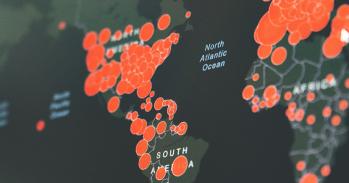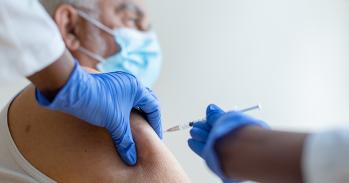
Cambridge researchers have shown how rapid genome sequencing of virus samples and enhanced testing of hospital staff can help to identify clusters of healthcare-associated COVID-19 infections.
Cambridge researchers have shown how rapid genome sequencing of virus samples and enhanced testing of hospital staff can help to identify clusters of healthcare-associated COVID-19 infections.
This approach can provide vital information to help us to investigate the possible routes of transmission and to improve infection control measures to limit the spread of infection
Estee Torok
Since the start of the UK pandemic, when the virus was spreading between people, a team of scientists and clinicians at the University of Cambridge and Cambridge University Hospitals NHS Foundation Trust (CUH) have been reading the genetic code of the virus to see if cases within the hospital are connected. This has enabled the hospital to fully investigate these outbreaks and to improve infection control measures to reduce the risk of further infections.
In addition, the introduction of a screening programme that involved repeat testing of staff, has helped the hospital to investigate clusters of COVID-19 infections, informing infection control measures and breaking chains of transmission. This has helped reduce the number of hospital-acquired infections, ensuring maximum safety for patients and staff as the NHS aims to re-start other services.
Researchers have published details of these investigations in two peer-reviewed journals, Lancet Infectious Diseases and eLife.
Genomic surveillance
Researchers in Cambridge have previously pioneered the use of genome sequencing as a way of managing hospital infections such as methicillin-resistant Staphylococcus aureus (MRSA), vancomycin resistant enterococci (VRE) and Clostridium difficile. They have also used real-time sequencing to rapidly identify transmission chains in epidemics such as the Ebola epidemic in Sierra Leone.
The researchers have now turned their attention to COVID-19.
SARS-CoV-2, the coronavirus that causes COVID-19, is an RNA virus and as such its genetic code is prone to errors each time it replicates. It is currently estimated that the virus mutates at a rate of 2.5 nucleotides (the A, C, G and T of genetic code) per month. Reading – or ‘sequencing’ – the genetic code of the virus can provide valuable information on its biology and transmission.
As part of the COVID-19 Genomics UK (COG-UK) Consortium, researchers have been sequencing all available positive samples from patients admitted to the hospital with COVID-19 infection as well as a selection of samples collected from patients in regional hospitals across the East of England.
In a five week period from mid-March to late April, the team sequenced over 1,000 viral genomes. They used phylogenetic trees – akin to a ‘family tree’ – to look at how clusters of virus samples might be related, allowing them to help pinpoint particular wards or locations where the disease was spreading.
Dr Estée Török from the Department of Medicine at the University of Cambridge said: “Genome sequencing gives us a rapid and reliable way of identifying cases of COVID-19 infection that are closely related within the hospital. This approach can provide vital information to help us to investigate the possible routes of transmission and to improve infection control measures to limit the spread of infection.”
The researchers analysed 299 COVID-19 patients and found 35 clusters of genetically identical viruses involving 159 patients. By examining the patients’ medical records and ward location data researchers identified strong links between 58% of cases and plausible links between 20% of cases. The epidemiological and genomic data were fed back to the hospital infection control and management teams resulting in implementation of a range of measures to prevent further transmission, including isolation of infected patients, revised procedures for ward cleaning, enhanced use of personal protective equipment (PPE) and changes in staff social distancing behaviour.
As an example, six dialysis patients were admitted to different locations in the hospital with COVID-19 infection over a three-week period. Sequencing revealed that their viral genomes were identical. Epidemiological investigation showed that the patients dialysed at the same outpatient dialysis unit on the same days of the week and identified shared patient transportation and neighbouring dialysis chairs as risk factors for transmission. This enabled the infection control team to enhance infection control measures and prevented additional cases.
Professor Ian Goodfellow, from the Department of Pathology at the University of Cambridge, said: “We’re able to combine genomic data with patients’ medical records to provide real time information to help the hospital review its infection control on a weekly basis. It’s also highlighted possible transmission networks less well documented, such as care homes, outpatient units and ambulance services.”
The COVID-19 Genomics UK Consortium is supported by funding from the Medical Research Council, part of UK Research & Innovation (UKRI), the National Institute of Health Research and the Wellcome Sanger Institute.
Screening asymptomatic and symptomatic healthcare workers
In addition to genomic surveillance, CUH has implemented a screening programme in which all staff – both symptomatic and asymptomatic – are screened.
In May, Cambridge researchers reported that of the more than 1,000 staff members reporting fit for duty during April, 3% tested positive for the coronavirus.
Now, in a follow-up study published in eLife, they have found that, alongside a decline in patient admissions with COVID-19, the proportion of both asymptomatic and symptomatic healthcare workers testing positive declined rapidly throughout the following month.
The team performed 3,388 tests at CUH between 25 April and 24 May. These included 2,611 tests on asymptomatic healthcare workers. The samples were analysed using a technique called PCR to detect genetic information from the virus on the swab.
The researchers found that just 21 (0.8%) of the 2,611 tests carried out on asymptomatic healthcare workers returned positive, a large drop compared to the previous month.
Of the 771 tests carried out on symptomatic healthcare workers or those living with someone with possible infection, just 13 (1.7%) were positive – compared to 13% the previous month.
Dr Mike Weekes, from the Cambridge Institute of Therapeutic Immunology and Infectious Disease (CITIID), said: “Screening all staff at the hospital regardless of whether they are showing symptoms has helped us see a dramatic fall in the number of hospital-acquired infections. It means we’re able to spot new outbreaks faster, limiting their opportunity to spread.
“It’s important not to be complacent, though. There will inevitably be new outbreaks that occur – that is, unfortunately, the nature of a pandemic. But we hope our approach will help reassure both staff and patients that the hospital remains a safe place to give and receive care.”
In their report, the team give an example of where four symptomatic staff from the same general medical ward tested positive. In response, the team was able to carry out targeted screening of staff on the ward, allowing them to identify a cluster of infections and prevent further onward transmission.
“The existence of clusters of infection in specific areas of the hospital shows the potential for staff and patients to become infected within the hospital environment,” said Professor Steve Baker from CITIID. “If left unchecked, these clusters could lead to self-sustaining outbreaks. Frequent testing at CUH allowed us to spot these clusters quickly and stop any further transmission.”
The research was supported by Wellcome, the Addenbrooke’s Charitable Trust, the Medical Research Council, NHS Blood and Transfusion, National Institute for Health Research Cambridge Biomedical Research Centre and Cancer Research UK.
Reference
Meredith, LW, Hamilton, WL, et al. Rapid implementation of real-time SARS-CoV-2 sequencing to investigate healthcare-associated COVID-19 infections. Lancet ID; 14 July 2020; DOI: 10.1016/S1473-3099(20)30562-4
Jones, NK, Rivett, L, Sparkes, D, and Forrest, S et al. Effective control of healthcare worker SARS-CoV-2 transmission in a period of declining community prevalence of COVID-19. eLife; 19 June 2020; DOI: 0.7554/eLife.59391

The text in this work is licensed under a Creative Commons Attribution 4.0 International License. Images, including our videos, are Copyright ©University of Cambridge and licensors/contributors as identified. All rights reserved. We make our image and video content available in a number of ways – as here, on our main website under its Terms and conditions, and on a range of channels including social media that permit your use and sharing of our content under their respective Terms.




